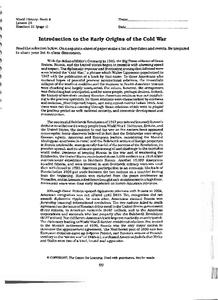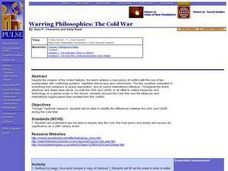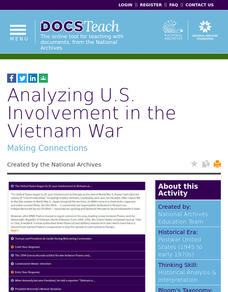Smithsonian Institution
The Price of Freedom: Americans at War
An interactive resource covers all of the United States' most prominent and influential historic wars including the Vietnam War, the Cold War, the War of 1812, and the Korean War. Learners observe cause and effect as well as how violence...
Curated OER
Introduction to the Early Origins of the Cold War
In this Cold War worksheet, students read a 4-paragraph selection about post World War II diplomacy and then list key dates and events noted in the selection.
Curated OER
Cold War Chronology
In this Cold War worksheet, learners examine the chronological list of important events between 1945 and 1991. Students then respond to 7 short answer questions based on the chronology.
University of California
Decolonization
The ripple effect from one small event can impact many others. Young historians research the ripple effect World War II had on decolonization in the second installment of an eight-part series. Through primary and secondary documents as...
University of California
Principles vs. Practices
Have you ever wondered what your own World Order would look like? Scholars use primary and secondary documents as well as video clips to investigate and analyze the Cold War. Using the sources, the principles and practices of nations...
Curated OER
Creating a Newscast on the Cold War
Students research the events of a specific year of the Cold War. In this Cold War lesson, students investigate the causes of the Cold War and highlight the events of a particular year. Students create a storyboard and a video newscast...
Curated OER
Sources of the Cold War
Fourth graders make a time line from their notes and outlines of the causes of the Cold War.
Curated OER
Who Was Responsible for the Start of the Cold War?
Students determine who is responsible for the start of the Cold War. In this Cold War lesson, students conduct their own research about the evolution of the war and write essays that reveal their opinion on how the war began.
Curated OER
Cold War
Eleventh graders demonstrate their knowledge of the causes and effects of the Cold War.
Curated OER
The Cold War
Tenth graders explore the origins of the Cold War. In this Cold War lesson plan, 10th graders analyze selected songs and identify what historical events they reference. Students create a musical collage or timeline for the period since...
Curated OER
The Cold War at Home
Eleventh graders discover the perspective of Cold War on the American homefront. In this Cold War instructional activity, 11th graders watch Duck and Cover video segments that instruct citizens what to do in case of nuclear attack....
Curated OER
The Cold War in Popular Music
High schoolers analyze pop culture songs to identify cold war themes and chart. They comprehend and explain why the Cold War took place and ended and assess its significance as a 20th century event. Students conduct a song analysis of...
Curated OER
Intro to the Cold War
Eleventh graders examine the Cold War. In this American History activity, 11th graders develop answers to comprehension questions about the song "We Didn't Start the Fire". Students write a persuasive essay at the end of the unit.
Curated OER
Introduction to the Early Origins of the Cold War
In this Cold War activity, students read an article titled "Introduction to the Early Origins of the Cold War," and then make a list of key dates and events from the selection.
Curated OER
Astronomy and the Cold War: How the United States Used the Moon to Target the Soviet Union
Students examine how astronomical observations were used to help target sites in the Soviet Union during Cold War and why such targeting was needed. Students then make predictions and observations of same astronomical events for their...
Curated OER
Cold War into Guerilla War
Students examine the Cold War and the War on Terror. In this American history lesson plan, students research print and nonprint resources regarding both wars. Student compare the experiences of youth at the time so both the Cold War and...
Curated OER
Introduction to the Cold War
Students explore the correlation between the Cold War and the Domino Theory. In this history lesson, students watch a short video that exhibits the domino effect, then divide into small groups, each representing an assigned country, and...
Curated OER
Warring Philosophies: The Cold War
Students explain why the Cold War took place and ended. They analyze its significance as a 29th century event. Students identify the differences between the USA and USSR during the Cold War.
University of California
Hot Spots Research Project
The Cold War was only between the US and the USSR, right? Wrong! Scholars use primary and secondary resources to analyze the global impact of the Cold War. The fourth installment of an eight-part series culminates in the creation of a...
DocsTeach
Analyzing US Involvement in the Vietnam War
War: unavoidable or a necessary evil? A thought-provoking activity explores the United States' long involvement in the Vietnam War as well as the aftermath. Scholars research and summarize primary documents and complete online worksheets...
Center for History Education
The Cuban Missile Crisis
Cold War tensions led to hostile actions. Scholars use primary sources to understand the Bay of Pigs and the Cuban Missile Crisis during President Kennedy's administration. The lesson provides primary sources and a graphic organizer to...
New York State Education Department
US History and Government Examination: August 2013
While the United States is now one of the strongest countries in the world, at its founding, it was plagued by controversies over the ratification of the Constitution, the Louisiana Purchase, and the expansion of slavery. Using a...
DocsTeach
Landing a Man on the Moon: President Nixon and the Apollo Program
Take the small step for man and giant leap for mankind with the Apollo astronauts using primary sources. Young historians explore the documents related to the American space program up through the lunar landing, including presidential...
Curated OER
The Arab-Israeli Conflict
Provide your class with a context and series of events that has led to the conflict in the Middle East. They read 4 separate passages and answer 1 critical thinking question for each. Four more questions are posed at the bottom of the...

























